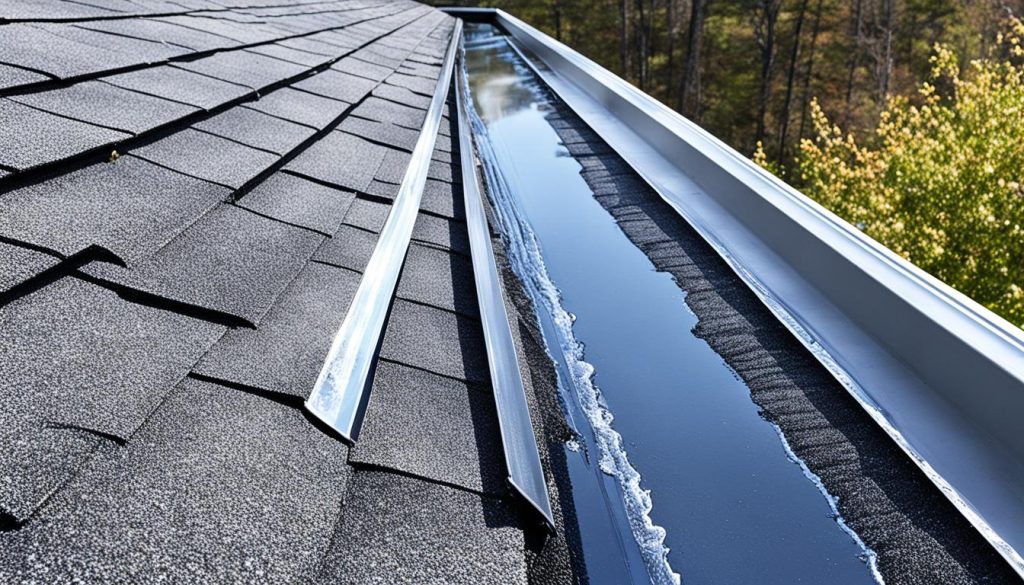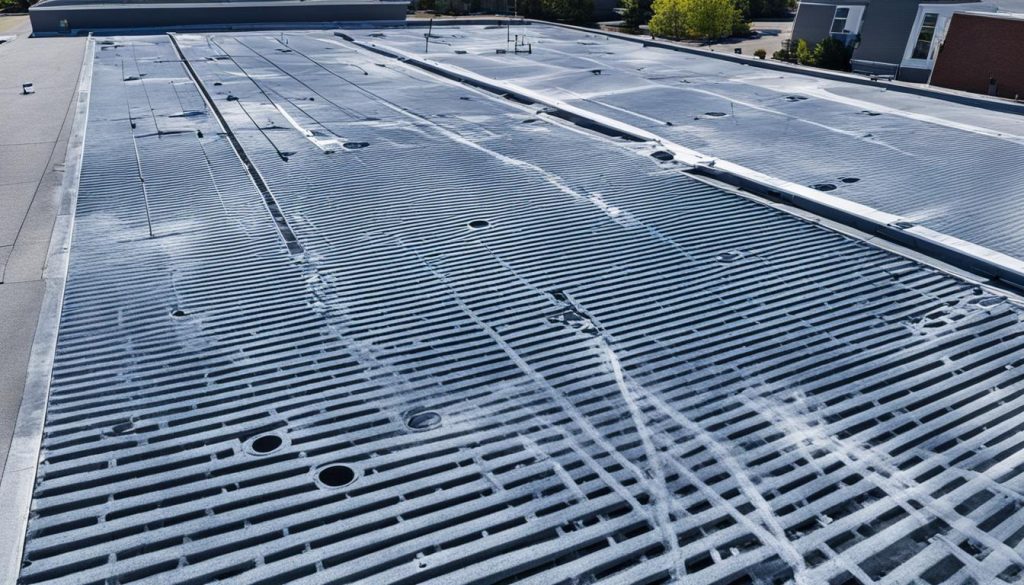Flat Roof Drainage Explained: Methods & Tips
Did you know that improper drainage on flat roofs can lead to ponding, which affects approximately 90% of all flat roofs in Canada?
Flat roofs require effective drainage systems to prevent water buildup and potential damage to the structure. There are various methods for optimizing flat roof drainage, including scuppers, gutters, and interior drains. Each system has its pros and cons, and choosing the right one is essential for preventing ponding and maintaining your flat roof’s integrity.
Key Takeaways:
- Improper drainage can lead to ponding, affecting the majority of flat roofs in Canada.
- Scuppers, gutters, and interior drains are the main drainage systems used for flat roofs.
- Scuppers are cost-effective and easy to maintain, but may not be as effective in heavy rain or snow.
- Gutters are customizable and cost-effective but require regular cleaning to prevent clogging.
- Interior drains offer protection and customization options but are more expensive to install.
- Consider factors such as cost, durability, and maintenance requirements when choosing a drainage system.
- Consulting with a roofing professional can help determine the best solution for your flat roof.
Scuppers: A Popular Drainage Option for Flat Roofs
When it comes to flat roof drainage systems, scuppers are a popular choice for both commercial and residential buildings. These drain openings, positioned on the side of a roof, effectively manage water on flat roofs. Scuppers offer several advantages that make them a preferred option for many property owners.
The Advantages of Scuppers
- Minimal Cost: Scuppers are a cost-effective drainage solution for flat roofs. Their simple design and installation process contribute to their affordability.
- Easy Maintenance: Unlike some other drainage systems, scuppers require minimal maintenance. Regular inspections and cleaning are typically all that’s needed to ensure proper water flow.
- No Clogging Issues: When scuppers are correctly sized and positioned, they offer efficient water drainage without the risk of clogging. This eliminates the need for constant maintenance and upkeep.
- Architectural Appeal: Scuppers can enhance the architectural appeal of a building. Their presence on the roofline adds a unique and aesthetically pleasing feature.
While scuppers offer a range of benefits, it’s important to note that they may not be as effective in severe weather conditions. Heavy downpours or significant snow accumulation can sometimes exceed the capacity of scuppers, potentially leading to water accumulation on the roof. Proper location and installation of scuppers are critical to ensuring effective water drainage and preventing any potential issues.
Comparing Drainage Options
| Drainage Option | Advantages | Disadvantages |
|---|---|---|
| Scuppers | Minimal cost Easy maintenance No clogging issues Architectural appeal |
May be less effective in severe weather |
| Gutters | Collects water effectively Cost-effective Customizable |
Requires regular cleaning Susceptible to damage from severe weather and debris |
| Interior Drains | Effective for large buildings Protected by the roof and walls |
Most expensive option Requires regular maintenance to prevent clogging |
Gutters: Cost-Effective Drainage Solution for Flat Roofs
When it comes to flat roof drainage, gutters are the go-to solution for many homeowners and builders. They play a crucial role in collecting water runoff from the roof and directing it away from the building and foundation. While flat roofs have low slopes to aid in water drainage, gutters provide additional protection by preventing water from cascading off the roof and causing damage to walls, doorways, and windows.
Gutters are not only practical but also cost-effective, making them a popular choice for flat roof drainage. They are relatively easy to install and can be customized to fit the specific needs of your roof. Whether you opt for seamless aluminum gutters or traditional vinyl gutters, there are plenty of options available to suit your budget and aesthetic preferences.
However, it’s important to note that gutters are not without their challenges. Over time, gutters may pull away from the fascia boards due to the weight of water and debris, which can lead to water leakage and structural damage. Additionally, gutters are vulnerable to damage from ice, debris buildup, and severe weather conditions. Regular maintenance and cleaning are necessary to ensure gutters remain free of clogs and in optimal working condition.
Proper flat roof grading for drainage is also essential when installing gutters. The roof should be sloped appropriately to ensure water flows towards the gutters and drains away effectively. If the grading is not correctly done, water may accumulate on the roof, leading to ponding and potential structural issues.
Overall, gutters provide a cost-effective and customizable solution for managing water runoff on flat roofs. With proper installation, regular maintenance, and correct roof grading, gutters can effectively protect your home or building from water damage, ensuring a dry and secure living environment.
Advantages of Gutters for Flat Roof Drainage:
- Cost-effective solution
- Customizable to fit specific roof needs
- Prevents water damage to walls, doorways, and windows
- Aids in proper flat roof grading for effective water runoff
Challenges of Gutters for Flat Roof Drainage:
- Potential for gutter pull away from fascia boards
- Prone to damage from ice, debris, and severe weather
- Regular maintenance and cleaning required
| Gutter Material | Pros | Cons |
|---|---|---|
| Aluminum | Lightweight, durable, and resistant to rust | Potentially higher cost compared to other materials |
| Vinyl | Affordable, easy to install, and low maintenance | Less durable and may become brittle over time |
| Steel | Durable and can withstand harsh weather conditions | Prone to rust without proper maintenance |
Interior Drains: A Practical Solution for Large Buildings
Interior drains are a highly effective and practical solution for large buildings that require optimal flat roof drainage design. These drain systems are strategically built into the structure before the roofing system is installed, allowing for efficient water removal and preventing ponding on flat roofs.
Interior drains utilize an internal system of pipes to carry water away from the building’s foundation, safeguarding the walls and structure from potential water damage. The advantage of interior drains is their ability to remain protected by the roof and walls, minimizing the risk of pipe bursts or freezing in harsh weather conditions.
Regular maintenance and checks are essential when using interior drains to prevent debris from clogging the system. This proactive approach ensures the system’s effectiveness and longevity, allowing for uninterrupted water flow and optimal flat roof drainage.
Advantages of Interior Drains:
- Efficiently carry water away from the building’s foundation
- Minimize the risk of pipe bursts or freezing
- Effectively protect walls and structure from water damage
However, it’s crucial to note that interior drain installation is the most expensive option among the various flat roof drainage systems available. The costs associated with the design, installation, and maintenance must be carefully considered during the planning phase, particularly for large buildings.
Comparison of Flat Roof Drainage Systems
| Drainage System | Advantages | Disadvantages |
|---|---|---|
| Scuppers | Low cost, easy maintenance, architectural appeal | Ineffective during severe downpours or heavy snowmelt |
| Gutters | Cost-effective, customizable | Require regular cleaning, susceptible to damage |
| Interior Drains | Efficient water removal, protection against freezing | Most expensive option, regular maintenance required |
By understanding the strengths and weaknesses of each drainage system, building owners and professionals can make informed decisions when it comes to flat roof drainage design. Consulting with experienced roofing specialists will provide valuable insights and ensure the selection of the most suitable system for specific building requirements.
Choosing the Right Drainage System for Your Flat Roof
When it comes to flat roofs, selecting the appropriate drainage system is crucial in preventing ponding and ensuring optimal water removal. Each drainage system has its own set of advantages and considerations that should be carefully evaluated before making a decision.
Scuppers are a popular choice for their affordability and easy maintenance. They provide an aesthetically pleasing solution and are relatively simple to install. However, it’s important to note that scuppers may not perform as effectively during heavy rainfalls or snowstorms. Consider whether your region experiences frequent severe weather conditions when assessing scuppers as an option.
Gutters, on the other hand, offer cost-effective and customizable solutions. They efficiently collect water from the roof and divert it away from the building and foundation, preventing potential damage. However, regular cleaning and maintenance are required to ensure optimal performance. Take into account the time and effort required for gutter cleaning when considering this option.
For those looking for enhanced protection and customization, interior drains can be an excellent choice. They are designed to carry water away from the foundation using an interior system of pipes. This option provides significant protection against the risk of burst pipes or freezing. However, it’s important to note that interior drains are the most expensive option and may require regular maintenance to prevent debris from clogging the system. Ultimately, consulting with a roofing professional will help determine the most suitable drainage system for your flat roof, taking into account factors such as cost, durability, and maintenance needs.
- Investing Wisely: How Windows & Doors in Boost Property Value and Financial Health - April 24, 2025
- The Financial Impact of Personal Injuries: Why Legal Help Matters for Business Owners - April 16, 2025
- The Hidden Financial Costs of Domestic Assault: What Business Owners Need to Know - April 16, 2025














